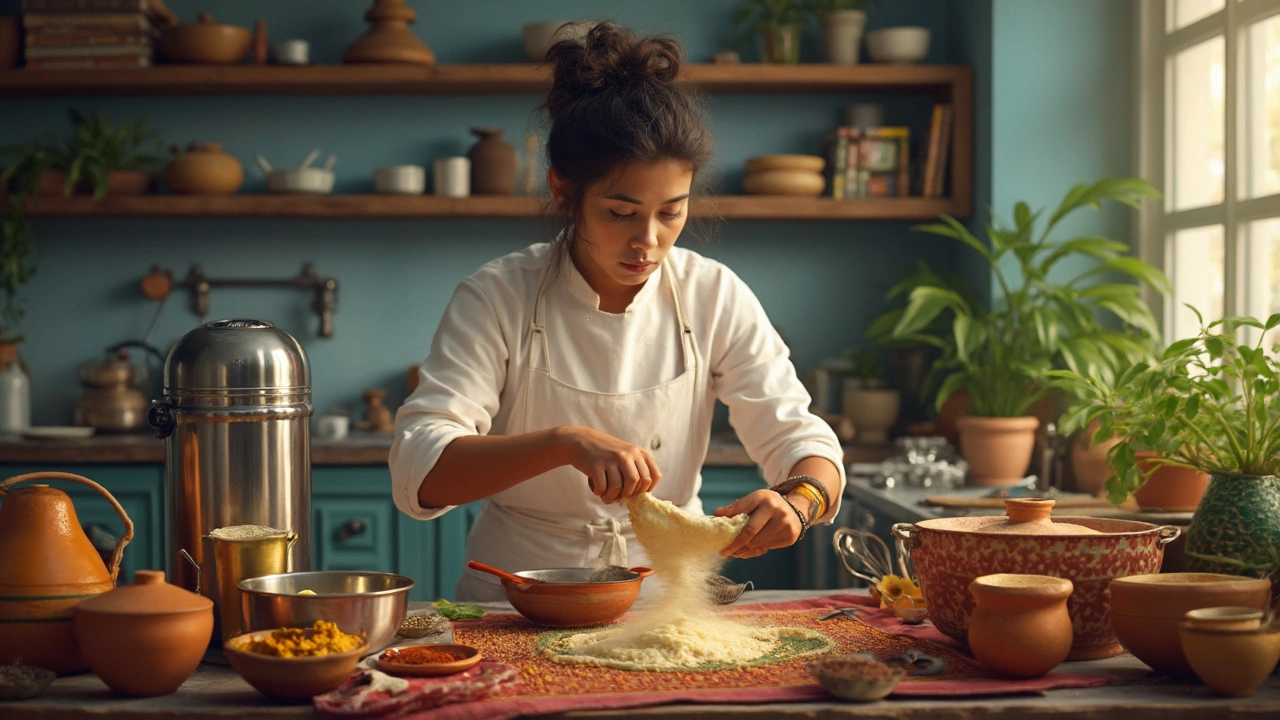Quickly Rise Dosa Batter Without Yeast: Simple Hacks
 Feb, 17 2025
Feb, 17 2025
If you're ever craving crispy, golden dosas but don't have hours to spare for fermenting batter, you're in good company. While traditional fermentation can take up to 12 hours, there are ways to speed up the process without sacrificing the delightful texture and flavor.
First off, let's get into why fermentation is essential. It releases those magical bubbles that give dosas their signature crispiness. But that doesn't mean you need to wait forever. Using warm water when blending your rice and urad dal is a good starting point. It gives the good bacteria a cozy environment to thrive and work faster.
- Understanding Dosa Fermentation
- Importance of Ingredients
- The Faster Fermentation Process
- Temperature Control Tips
- Emergency Hacks
Understanding Dosa Fermentation
Fermentation is the heart of making perfect dosa batter. It's what transforms simple ingredients into something magical and bubbly. The process usually involves mixing rice and urad dal, then letting them sit for hours until the batter rises like a fluffy cloud.
The Science Behind Fermentation
This whole fermentation thing isn’t just some ancient wisdom; it’s actually science. Wild yeast and helpful bacteria naturally present in the air and on the grains break down the sugars in the rice and dal. This chemical magic releases carbon dioxide, causing the batter to rise. That, my friend, is what makes the dosa crisp up beautifully when it hits the hot pan.
Conditions for Perfect Fermentation
Ever noticed how dosa batter ferments faster in the tropics? That's because temperature matters. A warm environment creates a happy home for the good bacteria and yeast, speeding up the process. Aim to keep your batter in a cozy spot, around 86°F (30°C), for best results.
Wondering about the role of salt in fermentation? Apart from enhancing taste, salt controls the growth of bacteria. Add it after the batter ferments to avoid slowing down the process.
Why It's Not Just About Time
While waiting time is often highlighted, it's not just about letting the clock run. Consistency of the batter, type of ingredients, and even your water's mineral content can tweak how fast or well the fermentation happens.
Isn't it cool how some cultures have nailed these techniques for centuries without the need for modern gadgets? This understanding might just make you appreciate the dosa on your plate a little more!
Importance of Ingredients
The secret behind a perfect dosa batter starts with the right ingredients. They can make or break your crispy dosa dreams. Let’s break down a few key players that are crucial for success.
Rice and Urad Dal Ratio
Getting the ratio of rice to urad dal right is the foundation. Typically, an ideal proportion would be 3:1. This combo ensures the batter has enough starch and proteins to feed the bacteria, leading to natural fermentation. Mixing up the ratio can result in dosas that are either too thick or too hard to handle.
Choice of Rice
Using parboiled rice is often recommended when making dosa batter. It helps in achieving the right fermentation and texture. Some folks mix it up with a bit of regular white rice for added crispiness, but that’s purely personal preference.
Enhancing Fermentation with Add-ins
Here's where a little kitchen magic comes into play. Adding a pinch of fenugreek seeds can do wonders. It not only boosts the fermentation process but also imparts a wonderful aroma and flavor. Sometimes, a handful of poha (flattened rice) is added into the mix to lighten the batter and help it rise better.
Water: The Unsung Hero
The amount of water affects fermentation big time. Too thick, and the batter struggles to rise. Too runny, and it doesn't hold. The key is a smooth, pourable consistency. Warm water can act as a catalyst, especially in cooler weather, giving the bacteria the warmth they need to get moving.

The Faster Fermentation Process
Getting that perfect dosa batter to rise quickly without yeast doesn't have to be rocket science. The key is creating an ideal environment for natural fermentation. Let's break down some steps that can cut down your wait time significantly.
Use Warm Water
When soaking rice and dal, use warm water. This little hack speeds up the awakening of the natural bacteria and enzymes present in your ingredients. It's like giving them a warm hug and saying, 'Let's get this party started!'
Blend It Right
Another trick is in the blending. Blend your ingredients until they are smooth but with a slight grittiness, like the texture of fine sand. A powerful blender can help speed this up, which means less time for the bacteria to activate.
Temperature and Placement
Where you store the batter makes a huge difference. Fermentation is temperature-dependent. Place your dosa batter in a warm spot in your kitchen, like near a stove or in an oven with just the light on. Avoid chilling places, as they slow the process down.
Magic Ingredients
A pinch of sugar can work wonders since it acts as fuel for the bacteria, causing the batter to rise faster. Some people also swear by adding a teaspoon of fenugreek seeds to the mix, which aids fermentation.
Shorten the Waiting Game
- Grind the soaked rice and dal with lukewarm water.
- Add a pinch of sugar and, optionally, fenugreek seeds.
- Place the batter in a warm area.
- Watch for bubbles or a slight rise—usually in 4–5 hours.
Quick Stats
| Step | Typical Time Reduction |
|---|---|
| Using Warm Water | Reduces 1-2 hours |
| Add Sugar | Reduces 30 mins-1 hour |
Following these steps not only saves time but also maintains that authentic dosa flavor. Experiment with these methods, and soon enough, quick, delicious dosas will become part of your routine!
Temperature Control Tips
You might think fermenting dosa batter without yeast is a lost cause, but turns out, it's all about the temperature! The good bacteria responsible for fermentation thrive best at warmer temperatures.
Set the Scene
Simply aiming for the right room temperature can make a big difference. If you're in a cooler climate, you might need to get a little creative.
- Use the Oven: No, not for baking! Just turn on the oven light and place your batter inside. The light provides enough warmth to encourage the batter to rise, without turning up the heat.
- Find a Sunny Spot: If you're lucky enough to have sun shining through during the day, place your covered batter near a window where it can soak up some rays.
The Ideal Temperature
The sweet spot for fermentation is around 30°C (86°F). While it doesn't have to be perfect, try to get as close as possible for best results. Here's a quick tip: wrap the container in a warm towel to maintain the heat.
Pro Tip
A nifty trick is to add a pinch of sugar to the batter. Sugar acts as quick food for the bacteria, making them more active, especially at the right temperature. But remember, just a pinch, as you don't want sweet dosas!
These steps might require a little planning, but they're totally worth it when all you want is that perfect dosa without the long wait. And if you nail this, you might just become the dosa guru in your circle!

Emergency Hacks
Sometimes, emergencies call for desperate measures, especially when you're eager for those mouthwatering dosa without the wait. Here are some quick hacks to speed up the process without using yeast.
Instant Rise with Baking Soda
A little known trick in the no yeast recipes playbook is adding baking soda. Just a pinch can increase the aeration of the dosa batter. Stir it in just before cooking, and you'll notice your dosas getting fluffier. Keep in mind, too much can alter the taste, so proceed with caution.
Microwave Technique
If it's too cold for the batter to ferment naturally, a quick microwave trick might help. Pour the batter into a microwave-safe bowl, heat for about 30 seconds—not to cook, just to warm slightly. This helps kickstart the fermentation process quickly.
Kickstart with Cooked Rice
If you're in a rush, consider blending a bit of cooked rice into your dosa batter. This acts like a natural quick-fermenter because it gives the bacteria more sugars to feast on, speeding up the process. Just ensure it’s finely blended to maintain a smooth consistency.
Using Fruit Peels
Using fruit, like a banana peel, might sound odd, but it's quite the secret weapon. Slip it into the batter for a few hours. The enzymes present encourage faster fermentation. Just remember to remove it before cooking up those dosas!
Warm Water Bath
Lastly, consider a warm water bath. Place your batter bowl inside a larger bowl filled with warm water and cover it up. This indirect warmth can speed things up without affecting taste or texture.
These emergency techniques ensure your dosa batter is ready to go without any fuss, and who doesn't love that?